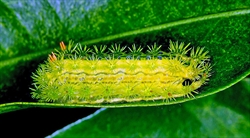Background
Limacodidae occur worldwide with around 1800 described species and many more undescribed. They mostly occur in the tropics. They are called cup moths because of the cup-like shape of the cocoons when missing their lids after adults emerge; the other common names (see above) refer to the distinctive and often painfully urticating caterpillars. In Australia we have about 70 species. The caterpillars vary in degrees of flatness from round or square in cross-section to flat and often appear to be slug-like. They need to be treated with caution as they are often armed with stinging, urticating hairs that can produce a severe reaction in humans. A definitive feature of the family is a modification of prolegs to sucker discs that adhere to smooth leaf surfaces. The head is concealed when feeding or at rest by a hoodlike prothorax (Fig. 1, Fig. 2).
Short Description
Adapted from Stehr et al. (1987), Common (1990) and Epstein et al. (1999).
Limacodid larvae have a variety of forms but are often round or square in cross-section to flat and often appear to be slug-like. The body is frequently adorned with long tubercles (including scoli) that may have stinging setae, or other, dorsal protuberances (including verrucae) with rosettes of stinging setae (Fig. 1, Fig. 2), but may also be smooth, bearing plates resembling armour or numerous short spines. They lack normal prolegs with crochets and have tiny thoracic legs. The unusual hag moth caterpillars in the New World (also known as monkey slugs) have hairy detachable lobes and resemble leaf debris (e.g. Phobetron). Caterpillars in the subfamily Chrysopolominae are of the smooth type, green or purple with long, black and hairlike setae with white tips at each end.
Diagnosis
Limacodid larvae are distinctive and relatively easy to distinguish from other families. They vary in degrees of flatness from round or square in cross-section to flat and often appear to be slug-like. They are the only caterpillars that lack normal prolegs with crochets that feed externally on leaves (Fig. 1, Fig. 2). In many species the prolegs have been replaced with sucker discs. These larvae could be confused with those of the butterfly family Lycaenidae, as they are also flattened. However, by contrast, lycaenid caterpillars possess more typical prolegs with crochets (although ‘primitive’ limacodids have crochets). The head is also extended in lycaenids while feeding, whereas in limacodids it is concealed when feeding (Fig. 1, Fig. 2).
Diagnostic characters that relate to prolegs are as follows:
Detailed Description
Adapted from Stehr et al. (1987), Epstein (1996) and Epstein et al. (1999).
Head: The head capsule is nearly always inconspicuous and concealed. When the head is withdrawn, the caterpillar can fold the front sides of the prothorax anteriorly to hide the head (Fig. 1, Fig. 2). The frontoclypeus is obscure, but is still divided into a frons and clypeus. The frons is short and bluntly pointed dorsally. It extends about one-third the distance to the epicranial notch. In the Limacodinae, the labrum often has an unusually large number of bristles covering the anterior margin. There are six stemmata. These are arranged in an arc except for number five which is ventral to the rest.
Thorax: The thoracic legs are relatively small to minute. The first thoracic segment is extended to cover the head (Fig. 1, Fig. 2). Its spiracle is pushed backwards to the posterior margin. T1 lacks any armature such as tubercles with spines but has lateral (L) setae that are hairlike, similar to those in the remaining thoracic and abdominal segments. T2 can partially extend over T1 during feeding or at rest and has dorsal (D) and subdorsal (SD) armature. Armature on T3 is usually the same as the abdominal armature but is often longer than that on segments A2-A3, and A5-A6 (Fig. 1, Fig. 2).
Abdomen: The dorsal (D) and subdorsal (SD) armature among the spiny caterpillars (nettles) often range from medium length to small or are absent on the D row. The SD row can be small or more elongate than the D row. The posterior abdominal segments have become reduced. A8 is reduced ventrally, A9 greatly reduced ventrally and A10 is small and ventral to A9, replacing A9’s venter (Fig. 1, Fig. 2). Prolegs are modified to sucker discs and usually without crochets. The spiracles on A1-8 are round and conspicuous, with A1 often dorsal to the rest in place of the SD scolus. Armature occurs in the form of scoli, verrucae and elongate tubercles or are the cryptic smooth type (Fig. 1, Fig. 2).
In the Chrysopolominae, the larvae are green or pink and spinulate, with long, black and hair-like setae with white tips. The spinules are evenly distributed over the dorsal side of the body but tend to be longer, where close to the spiracles. Caterpillars lack the multiple spines on the anterior margin of the labrum, commonly found in the rest of the family (Epstein 1996).
Species of Biosecurity Concern
THE FOLLOWING THREE SPECIES IN THE SUBFAMILY LIMACODINAE ARE OF BIOSECURITY CONCERN TO NORTHERN AUSTRALIA
Subfamily Limacodinae
Characteristics of this subfamily are as follows (Epstein et al. 1999):
- Typically feed on many foodplants
- Variable in form. Many urticating species with spines on scoli or sunken verrucae, elongate and sometimes detachable tubercles, and smooth species (known as gelatines) or those with gelatinous warts. All are located on T2, T3 and the abdominal segments A1-A9. (Fig. 1, Fig. 2, Fig. 3)
- Stemma 6 is the most isolated of the stemmata.
- Labrum often with a large number of bristles (absent in the Chrysopolominae).
- T1 with only primary setae.
- Thoracic legs small to minute.
- Suckers instead of prolegs on A1-A8, or A1-A7. Crochets are generally absent, with an exception in the African genera Taeda (=Pantoctenia) and Crothaema.
- Frass-flipping setae may be present.
Setora nitens (Limacodinae) (needle caterpillar, nettle grub, ulat bulu)
Description
(Fig. 2)
Mature caterpillars are usually green but can also be orange, red and other colours. This colour diversity is typical of polyphagous caterpillars. In green caterpillars, at least, the dorsal side has a prominent mid-dorsal, mauve band bordered with a dark green stripe. The mauve band is broken by large blue spots flanked directly by a short dark stripe and then a yellow blotch. The spiracles are large, oval and oblique. As is typical for the family, prolegs and crochets are absent.
The dorsal surface of the body is armed with urticating spines on prominent verrucae, which are larger on the thorax and A7. These end-verrucae point forwards and backwards, resembling horns; their spines are darker than the rest. The venom of the spines is exceptionally painful. Thus, the caterpillars should be handled with caution. Length around 20-39 mm (Cock et al. 1987).
Biology and Feeding Damage
These caterpillars feed on leaves. First instar caterpillars (2-4 mm) graze on the epidermis causing ‘windows’ to form in leaves. Mature caterpillars feed from the outer edges of leaves, leaving the mid-vein. The more mature fronds are favoured, but younger fronds are attacked when populations increase. Pupation occurs in the base of the trunk or in other herbaceous vegetation. The species is prone to occasional outbreaks when environmental conditions are favourable (Cock et al. 1987).
Current Distribution
- Indonesia
- Thailand
- Vietnam (above three from Australian Government Department of Agriculture and Water Resources, 2015)
- Malay Peninsula
- Java
- Sumatra (above three from Cock et al. 1987)
Caterpillar Host Plant
This species is highly polyphagous. Known hosts are as follows (Cock et al. 1987):
- African oil palm (Elaeis guineensis)
- coconut palm (Cocos nucifera)
- sago (Metroxylon sagu)
- nipa palm, mangrove palm (Nypa fruticans)
- banana palm (Musa)
- mango (Mangifera)
- diverse dicotyledonous trees, including the following:
- cacao (Theobroma cacao)
- Cinchona
- citrus (Citrus)
- coffee (Coffea)
- tea (Camellia sinensis)
***
Darna trima (Limacodinae) (nettle caterpillar)
This species is polyphagous but it outbreaks and exerts most damage in palms, especially oil palms.
This species has two recognised subspecies:
- Darna trima trima (Java)
- Darna trima ajavana (Sumatra, Java, Borneo, Singapore and Peninsular Malaysia) (CABI 2019)
Description
Mature larvae: Length around 15 mm. Body elongate with the first half swollen. The first thoracic segment is brown with the remaining body dark brown and translucent dorsally, flanked by pale narrow subdorsal stripes with pairs of dark spots along the length. The body has rows of scoli with stinging spines. The dorsolateral scoli are small; the lateral scoli and spines increase in size posteriorly. A contrasting pale green, edged with pale yellow to white, triangular section divides the sub-lateral part of the abdomen. The sub-lateral parts of A7-10 are similarly patterned. (Holloway 1986).
For an image and more information see: http://www.mothsofborneo.com/part-1/limacodidae/limacodidae-42-10.php
For detailed information see CABI (2019a): https://www.cabi.org/isc/datasheet/17934
Biology and Feeding Damage
This species is polyphagous but is especially injurious to oil palms (Elaeis), in which outbreaks often occur.
The caterpillar eats flowers, fruits, seedlings and leaves.
Oil palms: Lacerations caused by immature caterpillars become necrotic leading to elongated holes surrounded by brown tissue. Mature caterpillars strip leaflets to the midribs. In severe infestations entire fronds become necrotic.
Cocoa: Dieback of lateral branches and excessive production of lateral buds.
CABI (2019a)
Current Distribution
- Indonesia
- Malaysia
- Singapore
CABI (2019a)
Caterpillar Host Plants
This species is polyphagous and has a very wide host range covering many families. CABI (2019a)
***
Parasa lepida (Limacodinae) (nettle caterpillar, blue-striped nettle grub)
This species is native to the Indo-Malayan region and is considered to be a minor pest in a wide variety of crops.
Description
(Fig. 3)
The mature caterpillar is pale green, whitish or bright-yellowish green on the dorsal surface, with a vivid mid-dorsal blue band. The body has several other longitudinal, wavy, green bands. Like most limacodids it has sub-dorsal and sub-lateral series of scoli with short spines. Anterior and posterior spines have red tips. Length of mature caterpillars is approximately 40 mm.
See also: http://www.planthealthaustralia.com.au/wp-content/uploads/2013/03/Blue-striped-nettle-grub-FS.pdf
Biology and Feeding Damage
The caterpillars feed externally on flowers, fruits, seedlings and leaves. This can cause premature fruit drop and necrosis and abnormal leaf fall. Mature caterpillars strip the leaves leaving only the midrib. CABI (2019b)
Current Distribution
Indo-Malayan region including:
- India
- Sri Lanka
- Vietnam
- Malaysia
- Indonesia
It has also been introduced into Japan. For a complete list see CABI (2019b).
Caterpillar Host Plants
- coffee (Coffea)
- rubber (Hevea brasiliensis)
- oil palm (Elaeis)
- cocoa (Theobroma cacao)
- cassava (Manihot esculenta)
- tea (Camellia sinensis)
- ebony (Diospyros)
- coconut (Cocos nucifera)
- Gliricidia
- banana (Musa)
- winged bean (Psophocarpus tetragonolobus)
- mango (Mangifera)
For more information see: http://www.planthealthaustralia.com.au/wpcontent/uploads/2013/03/Blue-striped-nettle-grub-FS.pdf
References
Australian Government Department of Agriculture and Water Resources (2015). Final report for the non-regulated analysis of existing policy for fresh mango fruit from Indonesia, Thailand and Vietnam. Department of Agriculture and Water Resources, Canberra. http://www.agriculture.gov.au/SiteCollectionDocuments/biosecurity/risk-analysis/policy-scientific-reviews/non-regulated-mango-fruit-indo-thai-viet.pdf
Centre for Agriculture and Bioscience International (CABI) (2019a). Invasive Species Compendium. Darna trima (nettle caterpillar) https://www.cabi.org/isc/datasheet/17934 Accessed September 2019.
Centre for Agriculture and Bioscience International (CABI) (2019b). Invasive Species Compendium. Parasa lepida (nettle caterpillar) https://www.cabi.org/isc/datasheet/38935 Accessed September 2019.
Cock, M. J. W., Godfray, H. C. J., Holloway, J. D., Greathead, A. H., & C.A.B. International. (1987). Slug and nettle caterpillars: The biology, taxonomy, and control of the Limacodidae of economic importance on palms in South-east Asia. Wallingford, UK: C.A.B. International.
Common, I. F. B. (1990). Moths of Australia. Melbourne University Press, Collingwood, Victoria.
Epstein, M.E. (1996). Revision and phylogeny of the limacodid-group families, with evolutionary studies on slug caterpillars (Lepidoptera: Zygaenoidea). Smithsonian Contributions to Zoology, 582.
Epstein, M.E., Geertsema, H., Naumann, C.M., Tarmann, G.M., (1999). The Zygaenoidea. In: Kristensen, N.P. (Ed.), Handbook of Zoology. 4(35.1). De Gruyter, Berlin, New York, pp. 159–180.
Holloway, J. D. (1986). Key to Families: Cossidae, Metarbelidae, Ratardidae, Dugeonidae, Epipyropidae, Limacodidae. Malayan Nature Journal. The Moths of Borneo. Vol. 40: Part 1.
Koh, L. P. (2008). Birds defend oil palms from herbivorous insects. Ecological Applications, 18:4, 821-825.
Nagamine, W. T. and Epstein, M.E. (2007). Chronicles of Darna pallivitta (Moore 1877) (Lepidoptera: Limacodidae): biology and larval morphology of a new pest in Hawaii. The Pan-Pacific Entomologist, 83(2), 120-135, (12 May 2007). https://doi.org/10.3956/0031-0603-83.2.120
Murphy, S. M., Lill, J. T., Epstein, M. E. (2011) Natural history of limacodid moths (Zygaenoidea) in the environs of Washington, DC. Journal of the Lepidopterists Society, 65(3), 2011, 137–152. https://doi.org/10.18473/lepi.v65i3.a1
Stehr, F.W., Martinat, P.J., Davis, D.R., Wagner, D.L., Heppner, J.B., Brown, M.E., Toliver, M.E., Miller, J.Y., Downey, J.C., Harvey, D.J., McFarland, N., Neunzig, H.H., Godfrey, G.L., Habeck, D.H., Appleby, J.E., Jeffords, M., Donahue, J.P., Brown, J.W. & Frack, D.C. (1987). Order Lepidoptera, pp 288–596. In Stehr, F. W. (Ed.), Immature Insects. Kendall/Hunt, Dubuque.
Zaspel, J. M., Weller, S. J., Epstein, M. E. (2016). Origin of the hungry caterpillar: Evolution of fasting in slug moths (Insecta: Lepidoptera: Limacodidae), Molecular Phylogenetics and Evolution, 94, Part B: 827-832 https://doi.org/10.1016/j.ympev.2015.09.017



